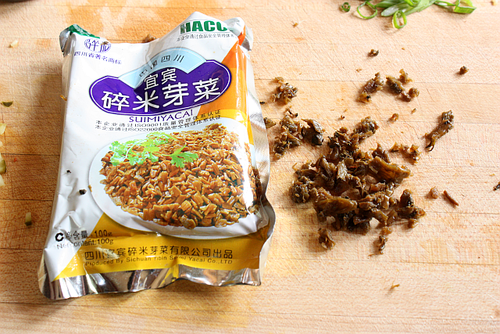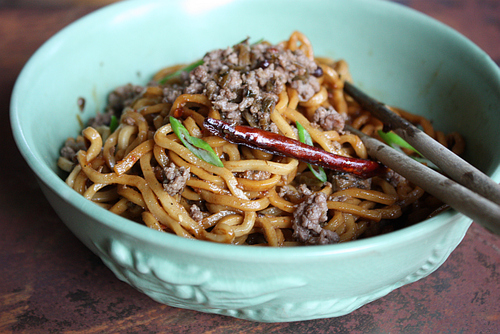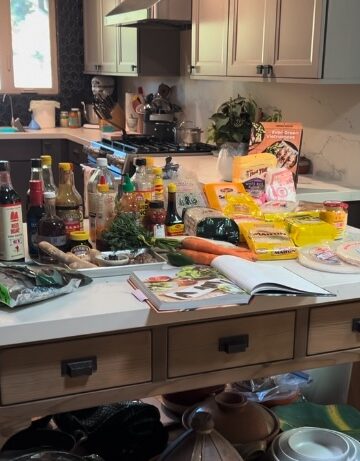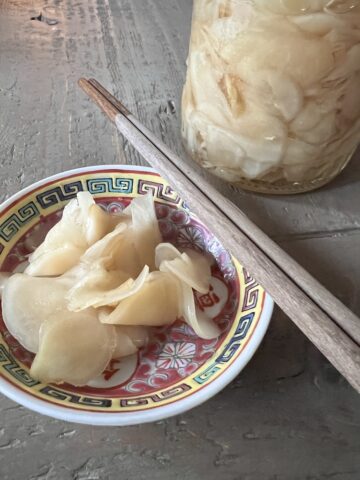Sometimes things are right under your nose and you don’t know it. For the dan dan noodle recipe that I wrote about in the Wall StreetJournal last week, I needed a specific seasoning ingredient – Chinese preserved mustard greens, called ya cai (“yaah tsai”). I went to my Chinese market and perused the dried vegetable and canned vegetable section. Nothing. I’d read about the ingredient in cookbooks but none of them told me how to find the stuff – where it may be located or how it’s packaged.
Then, while I was in the refrigerated section looking at tofu (what else) and noodles (for the recipe), I turned around and saw a bunch of boxes filled with index-card size packages of something. Remembering that my friend Victor Fong told me how his family often ate some super salty Chinese pickle with their rice, and that the salty pickle was sold in small packs, I took a look. Lo and behold, there were boxes of ya cai – the good kind made in Yibin in Sichuan province. I’d read in Land of Plenty by Fuchsia Dunlop thatthe ya cai from that city was famous and prized.
Ya cai is an ingredient that Sichuan is known for, and the package indicated in the top left corner that it was “Sichuan Famous Brand"; it's torn off in the photo below. That seemed hokey but it
means something in Asian food packaging. So does the HACCP labeling to indicate that decent food safety measures were in place. My only gripe is that I wish there was a best by date stamp. The manufacturer fit tiny tiny print on the package so be prepared.

It’s a small pack that cost around a dollar (I can’t remember because I was elated to find it!). The 100 grams (about 3.5 ounces ) is enough for many rounds of dan dan noodle. That said, I bought 3 packs.
So what does ya cai do for dan dan noodles? It gives the meat and sauce toppings an incredible umami funk and depth. I tried zha cai (Sichuan preserved mustard tuber, which I had around for savory tofu pudding) but it was overwhelming.
Ya cai was just right as a seasoning. In the photo at the top, you see it as small brown flecks. It’s salty and fermenty, which is why I thought of a decent substitute in kosher dill pickle. But side-by-side, dan dan noodles made with ya cai has an incredible flavor, a notch above the pickle which works in a pinch. The ya cai preserved greens contributes to dan dan’s signature Sichuan flavor.
I hope you go looking for it because I’ll be cooking with it more. It’s a cool ingredient to keep on hand. If you have experience with ya cai, what do you do with it?
Related Sichuan ingredient posts:


















Jennie says
I've been looking for this product for a while! I'm so glad you provided a picture because I've seen it in my local Asian grocery store but because I can't read a lot of Chinese, I didn't know whether this was it or not. So thanks! 😀
VR says
I like that you used the word "funk"- I think that is exactly right!
It's one of my favorite ingredients to whip up something very quickly when I am short on time & fresh groceries.
I also love it when I am under the weather- I make a sort of hot & sour soup- alongside shredded green cabbage, rehydrated shittake & diced tofu, finely sliced garlic- finished with a dash of soy sauce & sesame oil. It comes together in no time and that salty "funk" is exactly the flavor I look for when I can't stomach anything else.
Linda Anusasananan says
Looks like Tianjian preserved vegetable. Also reminds me of the preserved mustard greens (mei cai, moi choi) steamed with pork belly. Although that type uses more of the stems. I am going to look for this.
Suzette says
My first thought was also that it looks like the Tianjin preserved vegetable! Maybe all preserved funky veggies look alike... 🙂
Andrea Nguyen says
My pleasure, Jennie!
Andrea Nguyen says
VR -- Yeah, that fermented funk makes ya cai alluring. Thanks for sharing how you use it!
Andrea Nguyen says
I thought for a long time that it was the same as Tianjin preserved vegetable, which I bought in a crock long ago. But this ya cai in the package is nuanced. Very interesting.
Andrea Nguyen says
Suzette, I know what you mean. Shriveled up and brown. But they each have their little personalities.
Todd Tyrtle says
I thought I had figured it out when I just brought a piece of paper with the characters written on it and asked someone to show me where it was. Unfortunately, it appears the characters are the same as those for plain old bean sprouts. I must have looked silly asking for help finding them when there was a huge, un-missable display of them in middle of the produce department.
Kris says
Here is a link to buy the exact product shown on the picture above: http://posharpstore.com/en-us/yibin-suimi-yacai-35-oz-p1434.aspx
Anon. says
Indeed. "芽菜" (the Chinese characters for "yacai" (you can see it on the pack) usually DO mean "bean sprouts" (of various types of beans) almost anywhere else except in Sichuan. I found out only recently about "芽菜" as referring to this sort of preserved mustard basically IN SICHUAN. It also appears that "芽菜" referring to this sort of Sichuanese preserved mustard is not widely known elsewhere in China itself for that matter.
I'm surprised Andrea Nguyen doesn't mention this, as almost anywhere else if you ask for "yacai" or show the shopkeeper the Chinese characters for it you are probably going to be pointed to the plain bean sprouts, as you discovered yourself. Unless the shopkeeper knows about it or asks further questions or is Sichuanese himself/herself, of course.
From poking around on various Chinese sites I often find that the recipes spell out that one needs "碎米芽菜" (you can see this as the actual phrase used on the package) which is more-or-less "broken rice" yacai - rather than using the bare phrase 'yacai' ("芽菜") without further explaining that it is the *Sichuanese* "芽菜" that is meant. So what does one ask for if one wanted actual bean sprouts in Sichuan? I'm not sure, but I believe one would specify "豆芽菜" or, basically, "bean (豆) sprout (芽) vegetable (菜)", which is described as the specific type referring specifically to "bean sprouts" on Chinese web pages. Fuchsia Dunlop (who Andrea refers to as the reason for seeking out "yacai") does not call out what "bean sprouts" is, in Chinese, in her book (Land of Plenty) that Andrea refers to, and except for one recipe that does use bean sprouts (that I can see from the index) barely even seems to acknowledge the existence of bean sprouts. Dunlop on her website lists this "yacai" as this preserved vegetable and does say that anywhere else but in Sichuan one would tend to be directed to bean sprouts. (I was unable to find an entry for actual bean sprouts on her website from using the search function there - the only result from a search for "bean sprouts" is that entry describing this Sichuanese preserved vegetable)
Any folks from Sichuan or familiar with the issue want to confirm the term used for "bean sprouts" in Sichuan?
Kris says
In Sichuan, "bean sprouts" is called "豆芽" which means either mug bean sprouts "绿豆芽" or soy bean sprouts "黄豆芽"。 The former is usually for stir-fried with other vegetables "热菜", or stir-fried for cold dish "凉拌", while soy bean sprouts is more used to cook soups with such as tofu in sandy pots "砂锅豆腐".
The chopped yacai mentioned about or sell at http://posharpstore.com/en-us/yibin-suimi-yacai-7-oz-p1434.aspx is one most popular format, majorly used for stir-fried dishes, such as stir-fried green beans, or steam bun. The yacai selling at street corners in the Yibin culture area is not chopped. It can be added into many soups of chicken or duck
MC says
Hello! What happens if I don't use the whole bag? Can I keep it in the fridge? Thanks for your post!
leslie says
Is ya cai gluten free? I can use gluten free soy sauce and gluten free noodles, but I wasn't sure if the ya cai was gluten free.
El says
I couldn’t find them for years, so I used different types of olives instead. Very similar taste, but the texture is perfect!
Andrea Nguyen says
Great tip, El! Thank you.
Bill Schiff says
When you say different types, which type of olives did you find to be the best alternative to ya cai?
Andrea Nguyen says
I'm not sure, Bill. But you could use a salty green olive (no fancy Provence stuff). I'd shop at a Middle Eastern market for it.